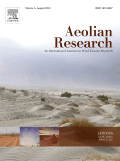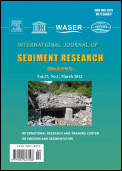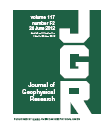
Aeolian Research
Scope & Guideline
Illuminating the Pathways of Wind and Sediment Interaction
Introduction
Aims and Scopes
- Aeolian Dynamics and Sediment Transport:
Research on the mechanisms and patterns of sediment transport by wind, including studies on saltation, creep, and the role of vegetation and surface roughness in influencing transport dynamics. - Geochemical and Mineralogical Analysis:
Investigations into the composition and characteristics of aeolian sediments, focusing on the geochemical properties, mineralogical composition, and their implications for environmental processes and health risks. - Remote Sensing and Modeling:
Utilization of remote sensing technologies and modeling approaches to study aeolian processes, including simulations of dune morphology, dust emission patterns, and the dynamics of wind erosion. - Impact of Climate and Land Use Change:
Examination of how climate change and land use practices influence aeolian processes, including changes in dust emissions, sediment transport, and the stability of dune systems. - Biogeomorphology and Interaction with Ecosystems:
Studies exploring the interactions between aeolian processes and biological systems, including the role of vegetation in stabilizing soils and influencing sediment transport. - Paleoenvironmental Reconstructions:
Research that utilizes aeolian sediments to reconstruct past environmental conditions and understand historical climate changes through geological records.
Trending and Emerging
- Machine Learning and Data-Driven Approaches:
The application of machine learning techniques to analyze aeolian processes and predict sediment transport dynamics is gaining traction. This trend highlights the integration of computational methods in environmental research. - Health Risks Associated with Aeolian Sediments:
Increasing attention is being paid to the health implications of dust emissions and windborne sediments, particularly in urban and agricultural contexts. This reflects a growing awareness of the environmental and public health impacts of aeolian processes. - Remote Sensing Applications:
The use of remote sensing tools for monitoring and modeling aeolian processes is on the rise, enabling researchers to gather large-scale data and analyze spatiotemporal patterns of dust events and sediment transport. - Climate Change Impacts on Aeolian Processes:
Research focusing on how climate change influences wind patterns, dust emissions, and sediment transport is increasingly prominent. This theme underscores the need for understanding the implications of global change on aeolian dynamics. - Interactions between Aeolian Processes and Ecosystems:
There is a growing interest in understanding how aeolian processes interact with biological systems, including the role of vegetation in dust stabilization and soil health. This interdisciplinary approach reflects a more holistic view of environmental systems.
Declining or Waning
- Traditional Wind Erosion Studies:
Research focused solely on traditional wind erosion measurements without integrating modern technologies or interdisciplinary approaches has decreased. The field is moving towards more complex models and integrated studies that include ecological and climatic factors. - Simplistic Dust Emission Models:
Basic models of dust emission that do not account for the complexities of environmental interactions, such as vegetation and climate variability, are less frequently published. There is a trend towards more sophisticated modeling that incorporates various influencing factors. - Single-Factor Studies:
Research that examines aeolian processes in isolation, without considering the broader environmental context, is waning. Current trends favor holistic studies that address multiple interacting factors affecting aeolian dynamics.
Similar Journals

International Journal of Sediment Research
Pioneering Research in Geology and StratigraphyThe International Journal of Sediment Research, published by KEAI PUBLISHING LTD, stands as a premier platform for advanced studies in the fields of geology and stratigraphy. With an impressive Q1 ranking in both categories in 2023, this journal hosts a wealth of research that has significantly contributed to our understanding of sediment dynamics and geological processes since its inception in 1981. The journal is dedicated to publishing high-quality research articles, reviews, and case studies that span a broad range of topics, including sedimentology, stratigraphic analysis, and environmental geology. Researchers, professionals, and students will find invaluable insights within its pages, courtesy of cutting-edge methodologies and rigorous peer-review standards. Despite its non-open access status, the journal ensures a global reach, facilitating knowledge sharing and collaboration among academia and industry. With a rich history and a forward-looking approach to scientific exploration, the International Journal of Sediment Research remains a vital resource for those committed to advancing our understanding of Earth's sedimentary systems.

JOURNAL OF GEOPHYSICAL RESEARCH-EARTH SURFACE
Pioneering Research on Earth's Surface Interactions.JOURNAL OF GEOPHYSICAL RESEARCH-EARTH SURFACE, published by the American Geophysical Union, stands as a leading voice in the fields of Earth-Surface Processes and Geophysics. With an impressive impact factor placing it in the Q1 category for both disciplines, this journal offers invaluable insights and research findings that address critical challenges related to Earth's surface dynamics and processes. Since its inception in 2004, the journal has been dedicated to fostering a deeper understanding and interdisciplinary exploration of topics critical to environmental science, geology, and geophysics. Researchers and professionals in the field will find cutting-edge studies meticulously peer-reviewed to ensure high quality and relevance, making it an essential resource for academics, practitioners, and students alike. The journal's significant Scopus rankings — 25th out of 179 in Earth-Surface Processes and 26th out of 165 in Geophysics — underscore its influence and the rigor of its content, encouraging submission and engagement from leading scholars globally.

BASIN RESEARCH
Your Gateway to Cutting-Edge Geological DiscoveriesBasin Research, published by Wiley, is a leading journal in the field of Geology, with a distinguished reputation affirmed by its Q1 ranking in the 2023 category of Earth and Planetary Sciences. Since its inception in 1988, the journal has been at the forefront of fundamental and applied research surrounding sedimentary basins, delving into their evolution, architecture, and dynamics. With an impressive Scopus rank of #36 out of 321, placing it in the 88th percentile, Basin Research serves as a critical platform for researchers, professionals, and students engaged in advancing our understanding of geological processes and their implications for natural resources and environmental policies. The journal is accessible to a global audience and emphasizes high-quality, peer-reviewed articles that cover a diverse array of topics from basin analysis to sedimentology and beyond. For those interested in deepening their insights into this vital area of study, Basin Research stands as an invaluable resource in the academic landscape.

EARTH SURFACE PROCESSES AND LANDFORMS
Pioneering Research in Geomorphology and HydrologyEARTH SURFACE PROCESSES AND LANDFORMS is a renowned academic journal dedicated to the comprehensive exploration of dynamic processes shaping the Earth's surface. Published by Wiley, this esteemed journal has established itself as a leading platform in the fields of Earth and Planetary Sciences, Geography, Planning, and Development. With an impressive Impact Factor and ranked in the Q1 category for multiple disciplines, it consistently features cutting-edge research that contributes to the understanding of geomorphology, hydrology, and related environmental phenomena. Researchers and professionals can benefit from the journal's extensive repository of high-quality studies, making it a crucial resource for advancing knowledge in these vital areas. As it continues to converge from 1981 to 2024, EARTH SURFACE PROCESSES AND LANDFORMS remains pivotal for scholars aiming to engage in high-level discourse and discovery in Earth sciences.

Paleoceanography and Paleoclimatology
Transforming Our Understanding of Ancient Environmental ChangesPaleoceanography and Paleoclimatology, published by the American Geophysical Union, is an esteemed open-access journal dedicated to advancing the fields of atmospheric science, paleontology, and oceanography. With an impressive Q1 ranking in all these categories for 2023, the journal is recognized for its impactful contribution, housing research that explores the intricacies of ancient oceanic and climatic systems from 2018 to 2024. Researchers benefit from its robust Scopus rankings, placing it among the top publications in both paleontology and oceanography, with ranks of #5 and #21, respectively, showcasing its significance in the academic community. The journal provides a vital platform for groundbreaking studies that address critical questions regarding Earth's historical climate and ocean processes, making it an essential resource for researchers, professionals, and students alike.

GEOARCHAEOLOGY-AN INTERNATIONAL JOURNAL
Connecting Geological Processes with Human NarrativesGEOARCHAEOLOGY-AN INTERNATIONAL JOURNAL is a leading peer-reviewed publication dedicated to the interdisciplinary study of the interactions between geology and archaeology. Published by Wiley in the United States, this esteemed journal serves as a vital platform for researchers and professionals in the fields of archaeology, earth sciences, and environmental studies. With an impressive impact factor and categorized in the Q1 quartile of subjects such as Archaeology and Earth and Planetary Sciences, it ranks among the top journals in its discipline, reflecting its significant contribution to academic discourse and research innovations. Since its inception in 1986 and projected to continue into 2024, GEOARCHAEOLOGY emphasizes the importance of integrating geological methods within archaeological research, fostering a deeper understanding of human history in relation to the earth’s processes. This journal is an indispensable resource for scholars and students alike who seek to explore the dynamic connections between past human behavior and the geological record.

Earth Surface Dynamics
Exploring the Forces Shaping Our PlanetEarth Surface Dynamics, published by COPERNICUS GESELLSCHAFT MBH, is a pioneering open-access journal dedicated to the study of geophysical processes and Earth-surface dynamics. Since its inception in 2013, this journal has established itself as a vital platform for disseminating high-quality research in the fields of Earth-Surface Processes and Geophysics, earning a prestigious Q1 ranking in both categories as of 2023. With an impressive Scopus ranking of #33 out of 179 for Earth-Surface Processes and #31 out of 165 for Geophysics, it captures the attention of leading researchers and professionals in the Earth sciences community. The journal is committed to providing a forum for innovative and interdisciplinary research that enhances our understanding of terrestrial environments and their dynamics, making it an essential resource for students, academics, and industry professionals alike. Please visit our journal to explore groundbreaking research and contribute to the ongoing dialogue in the dynamic field of Earth science.

Journal of Sedimentary Environments
Exploring the Dynamics of Earth’s Sedimentary Systems.Journal of Sedimentary Environments is a leading open-access publication dedicated to advancing the study of sedimentary processes and environments. Published by SPRINGER HEIDELBERG, this journal embraces a wide array of topics including sedimentology, paleoenvironments, and the interactions between sediments and ecosystems. Since its transition to open access in 2016, it has prioritized making high-quality research widely available, fostering collaboration and innovation among researchers, professionals, and students in the field. With a commitment to excellence, the journal aims to publish groundbreaking studies that enhance our understanding of sedimentary environments, making it an essential resource for anyone interested in the dynamics of Earth’s sedimentary systems. Located in Heidelberg, Germany, this journal is poised to play a vital role in shaping current and future research discussions worldwide.

Frontiers of Earth Science
Transforming Understanding of Planetary ProcessesFrontiers of Earth Science is a prominent academic journal in the field of Earth and Planetary Sciences, published by Springer. With an ISSN of 2095-0195 and an E-ISSN of 2095-0209, this journal serves as a significant platform for researchers and professionals to disseminate their findings from 2007 to 2024. It is recognized for its impactful contributions within the category of Earth and Planetary Sciences, boasting a respected Q2 ranking in 2023. With a Scopus ranking of 64 out of 195, placing it in the 67th percentile, Frontiers of Earth Science continues to drive academic dialogue and innovation. The journal is dedicated to exploring a diverse range of topics, including geology, meteorology, and environmental science, and amplifying the understanding of Earth systems through rigorous research. Located in New York, USA, this journal embraces an Open Access model, ensuring that groundbreaking research is readily available to the global scientific community, thereby enhancing its accessibility and impact.

Revista Brasileira de Geomorfologia
Advancing Knowledge in Geomorphological TransformationsRevista Brasileira de Geomorfologia is a prominent open-access journal dedicated to the field of geomorphology, fostered by the UNIAO GEOMORFOLOGIA BRASILEIRA since its inception in 2000. Based in Brazil, this journal serves as a vital platform for researchers, professionals, and students to disseminate and engage with cutting-edge research on the dynamic processes shaping the Earth's surface. With an ISSN of 1519-1540 and an E-ISSN of 2236-5664, it has earned its place within the academic community, ranking in the Q3 category in the Earth-Surface Processes domain according to the latest 2023 quartiles. The journal's metrics, including a Scopus rank of 123/179 within its category, reflect its commitment to quality research. By facilitating open access to its content, the Revista Brasileira de Geomorfologia not only promotes scholarly communication but also enhances the visibility of vital studies detrimental to understanding geomorphological transformations and environmental change. Join the ongoing discourse and contribute to advancing knowledge in this essential field of Earth sciences.